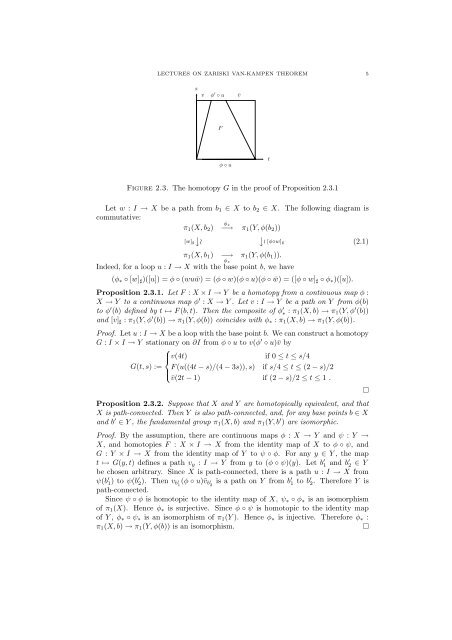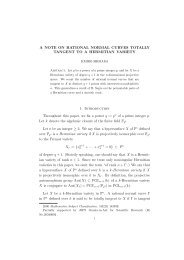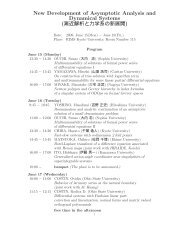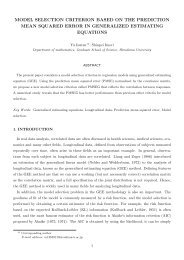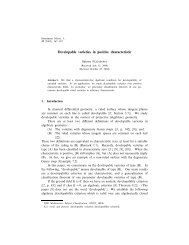LECTURES ON ZARISKI VAN-KAMPEN THEOREM 1. Introduction ...
LECTURES ON ZARISKI VAN-KAMPEN THEOREM 1. Introduction ...
LECTURES ON ZARISKI VAN-KAMPEN THEOREM 1. Introduction ...
You also want an ePaper? Increase the reach of your titles
YUMPU automatically turns print PDFs into web optimized ePapers that Google loves.
<strong>LECTURES</strong> <strong>ON</strong> <strong>ZARISKI</strong> <strong>VAN</strong>-<strong>KAMPEN</strong> <strong>THEOREM</strong> 5<br />
s<br />
v<br />
φ ′ ◦ u<br />
¯v<br />
F<br />
φ ◦ u<br />
t<br />
Figure 2.3. The homotopy G in the proof of Proposition 2.3.1<br />
Let w : I → X be a path from b 1 ∈ X to b 2 ∈ X. The following diagram is<br />
commutative:<br />
φ ∗<br />
π 1 (X, b 2 ) −→ π1 (Y,φ(b 2 ))<br />
⏐ ⏐<br />
[w] ♯↓ ≀<br />
↓ ≀ [φ◦w]♯<br />
(2.1)<br />
π 1 (X, b 1 ) −→ π 1 (Y,φ(b 1 )).<br />
φ∗<br />
Indeed, for a loop u : I → X with the base point b, wehave<br />
(φ ∗ ◦ [w] ♯ )([u]) = φ ◦ (wu ¯w) =(φ ◦ w)(φ ◦ u)(φ ◦ ¯w) =([φ ◦ w] ♯ ◦ φ ∗ )([u]).<br />
Proposition 2.3.<strong>1.</strong> Let F : X × I → Y be a homotopy from a continuous map φ :<br />
X → Y to a continuous map φ ′ : X → Y .Letv : I → Y be a path on Y from φ(b)<br />
to φ ′ (b) defined by t ↦→ F (b, t). Then the composite of φ ′ ∗ : π 1 (X, b) → π 1 (Y,φ ′ (b))<br />
and [v] ♯ : π 1 (Y,φ ′ (b)) → π 1 (Y,φ(b)) coincides with φ ∗ : π 1 (X, b) → π 1 (Y,φ(b)).<br />
Proof. Let u : I → X be a loop with the base point b. We can construct a homotopy<br />
G : I × I → Y stationary on ∂I from φ ◦ u to v(φ ′ ◦ u)¯v by<br />
⎧<br />
⎪⎨ v(4t) if 0 ≤ t ≤ s/4<br />
G(t, s) := F (u((4t − s)/(4 − 3s)),s) if s/4 ≤ t ≤ (2 − s)/2<br />
⎪⎩<br />
¯v(2t − 1) if (2 − s)/2 ≤ t ≤ 1 .<br />
Proposition 2.3.2. Suppose that X and Y are homotopically equivalent, and that<br />
X is path-connected. Then Y is also path-connected, and, for any base points b ∈ X<br />
and b ′ ∈ Y , the fundamental group π 1 (X, b) and π 1 (Y,b ′ ) are isomorphic.<br />
Proof. By the assumption, there are continuous maps φ : X → Y and ψ : Y →<br />
X, and homotopies F : X × I → X from the identity map of X to φ ◦ ψ, and<br />
G : Y × I → X from the identity map of Y to ψ ◦ φ. For any y ∈ Y , the map<br />
t ↦→ G(y, t) defines a path v y : I → Y from y to (φ ◦ ψ)(y). Let b ′ 1 and b ′ 2 ∈ Y<br />
be chosen arbitrary. Since X is path-connected, there is a path u : I → X from<br />
ψ(b ′ 1)toψ(b ′ 2). Then v b ′<br />
1<br />
(φ ◦ u)¯v b ′<br />
2<br />
is a path on Y from b ′ 1 to b ′ 2. Therefore Y is<br />
path-connected.<br />
Since ψ ◦ φ is homotopic to the identity map of X, ψ ∗ ◦ φ ∗ is an isomorphism<br />
of π 1 (X). Hence φ ∗ is surjective. Since φ ◦ ψ is homotopic to the identity map<br />
of Y , φ ∗ ◦ ψ ∗ is an isomorphism of π 1 (Y ). Hence φ ∗ is injective. Therefore φ ∗ :<br />
π 1 (X, b) → π 1 (Y,φ(b)) is an isomorphism.


